It is 'only by the grace of God' that Trump is alive: Trump senior adviser Jason Miller
Trump senior adviser Jason Miller reflects on the assassination attempt of the former president on 'Jesse Watters Primetime.'
A startling image of former President Donald J. Trump surviving an assassination attempt on Saturday in Butler, Pennsylvania, has become an instant cultural sensation.
Moments after a bullet struck his ear and missed a fatal headshot by mere millimeters, the former president and now 2024 GOP presidential nominee rose to his feet with blood streaked across his face and raised his fist in defiant triumph beneath an American flag in front of a blue, cloudless sky.
The scene, framed almost perfectly, was captured by AP photographer Evan Vucci.
MEET THE AMERICAN WHO STITCHED THE STARS & STRIPES, BETSY ROSS, REPUTED WARTIME SEDUCTRESS
Its visceral power drew widespread comparisons to some of the most patriotic images in American history, including Joe Rosenthal’s photograph of Marines raising the flag over Iwo Jima in World War II and Emanuel Leutze’s romanticized painting of "Washington Crossing the Delaware."
"What all these great flag photos or images have in common is artistic composition," Owen Conner, chief curator at the National Museum of the Marine Corps in Triangle, Virginia, told Fox News Digital this week.
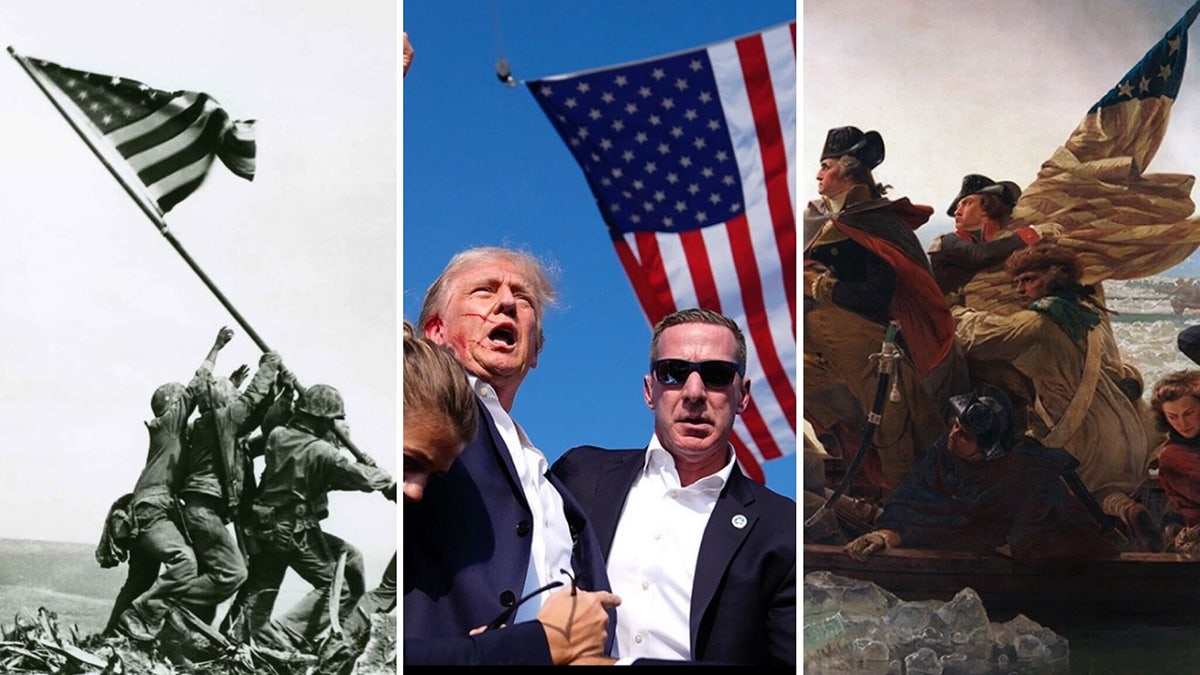
The American flag serves as a powerful symbol of triumph, struggle and defiance, captured in a handful of landmark moments in U.S. history. From left, U.S. Marines raise the flag on Iwo Jima in World War II; Donald Trump reacts to surviving an assassination attempt; and the Emanuel Leutze painting, "Washington Crossing the Delaware." (Joe Rosenthal/Universal Images Group via Getty Images; AP Photo/Evan Vucci; Universal History Archive/Universal Images Group via Getty Images)
Conner's collection includes that very same Iwo Jima flag seen in the iconic photo.
"The flag flying is just beautiful. But it’s hard to photograph. When the flag is captured the right way, it just tugs at the heartstrings."
"What all these great flag photos or images have in common is artistic composition."
The most memorable images of the flag, he said, "are not only symbolic and patriotic, they have the composition that makes them pieces of art."
Here's a look at eight powerful flag images in American history that have inspired the nation with their patriotic and artistic power.
2024: Trump rises after surviving assassination attempt
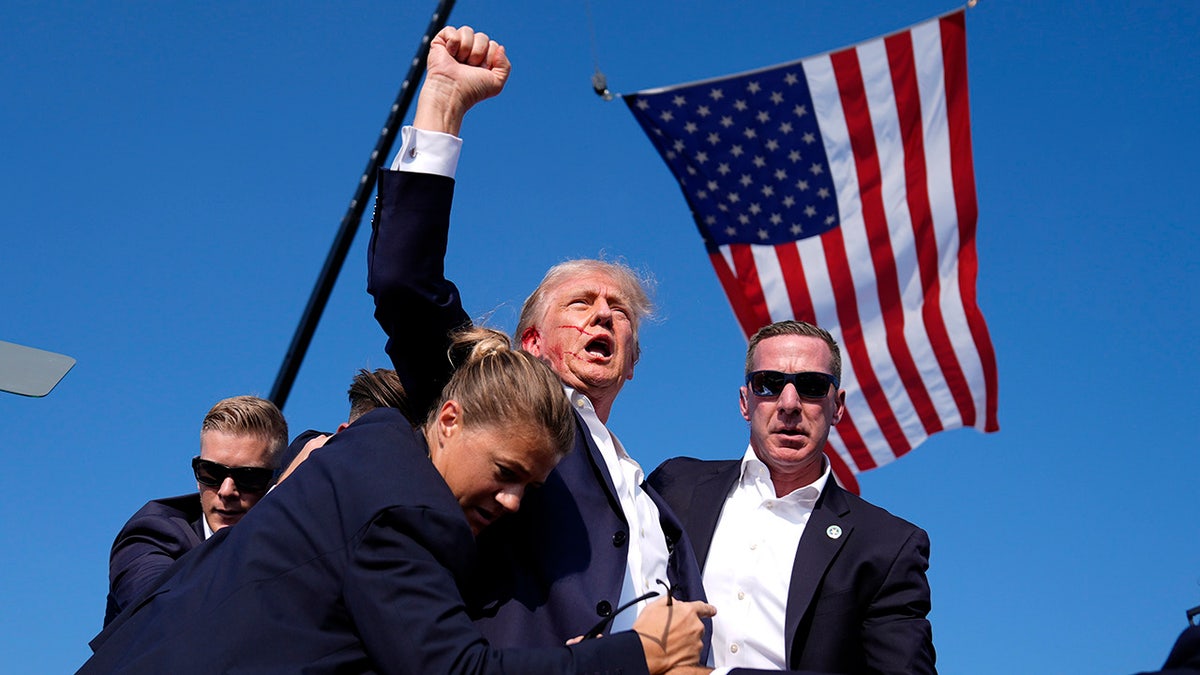
Former President Donald Trump is surrounded by U.S. Secret Service agents at a campaign rally on Saturday, July 13, 2024, in Butler, Pennsylvania, moments after Trump's ear was grazed by a gunman's bullet. (AP Photo/Evan Vucci)
Trump is the GOP nominee and the leading candidate to win the White House in November at a time when President Joe Biden appears to be suffering cognitive decline while revolt emerges within the Democrat Party.
What emerged on Saturday was an emotionally heroic scene that overshadows politics, said presidential historian Craig Shirley.
"There’s something inviting about that photo that shows strength. It shows fortitude," Shirley, the author of six biographies of President Ronald Reagan, told Fox News Digital in a phone interview on Monday. "People look at it and say, ‘Yes, I want to follow this guy."
The image of someone facing near-death, then rising beneath an American flag "touches people's hearts, their patriotic hearts," added Shirley.
"It’s going to be a historic image. It’s already historic."
2001: Americans raise the flag after the 9/11 terror attacks

First responders salute as an American flag is unfurled at the Pentagon at sunrise to commemorate the 2001 terrorist attack during an observance ceremony on Monday morning, Sept. 11, in Washington, D.C. (Manuel Balce Ceneta)
Americans instinctively reached for the Stars & Stripes as their first sign of hope after the Sept. 11, 2001, terror attacks. They do so each year as well to commemorate all those lost that day.
Three New York City firefighters hoisted an American flag at Ground Zero on Sept. 11, 2001, a photo of the red, white and blue in front of the gray burning wreckage of the World Trade Center a viral sensation. The following day, rescue workers hung a giant American flag over the side of Pentagon, its façade covered in soot.
Perhaps most significantly, Americans hoisted Old Glory from coast to coast: in front of their homes, attached to autos, stitched into T-shirts and stuck onto hats. Walmart reported that it sold 450,000 flags in the 48 hours after the terror attacks alone.
"While Americans had a shared sense of anguish after Sept. 11," Pew Research Center reported in 2021, "the months that followed also were marked by [a] rare spirit of public unity."
1980: ‘Miracle on Ice’ ignites patriotism, ends ‘malaise’

The 1980 USA hockey team celebrates its "Miracle on Ice" victory over the Soviet Union in Lake Placid, New York, as the American flag flies behind them. Fans celebrate in the streets waving American flags after the game. (Eric Schweikardt /Sports Illustrated via Getty Images; B Bennett/Getty Images)
The national malaise that dampened the national mood in the late 1970s was shattered in an organic eruption of red, white and blue fervor in an unlikely place: a hockey rink in Lake Placid, New York.
The American men’s hockey team shocked the sports world with a 4-3 victory over the Soviet Union in the 1980 Winter Olympics. The improbable victory was immediately dubbed the Miracle on Ice.
For more Lifestyle articles, visit www.foxnews.com/lifestyle
Americans responded with a renewed sense of flag-waving patriotism both in the streets of Lake Placid and nationwide, while U.S. goaltender Jim Craig was wrapped in an American flag by a fan after the team's gold medal win over Finland.
"To see the flags wave like that the night we beat the Russians and on the streets of Lake Placid and hear ‘The Star Spangled Banner’ on the podium was a very special moment for me and my teammates," team captain Mike Eruzione told Fox News Digital by phone Monday.
1970: ‘Patton’ stirs patriotism in divided United States
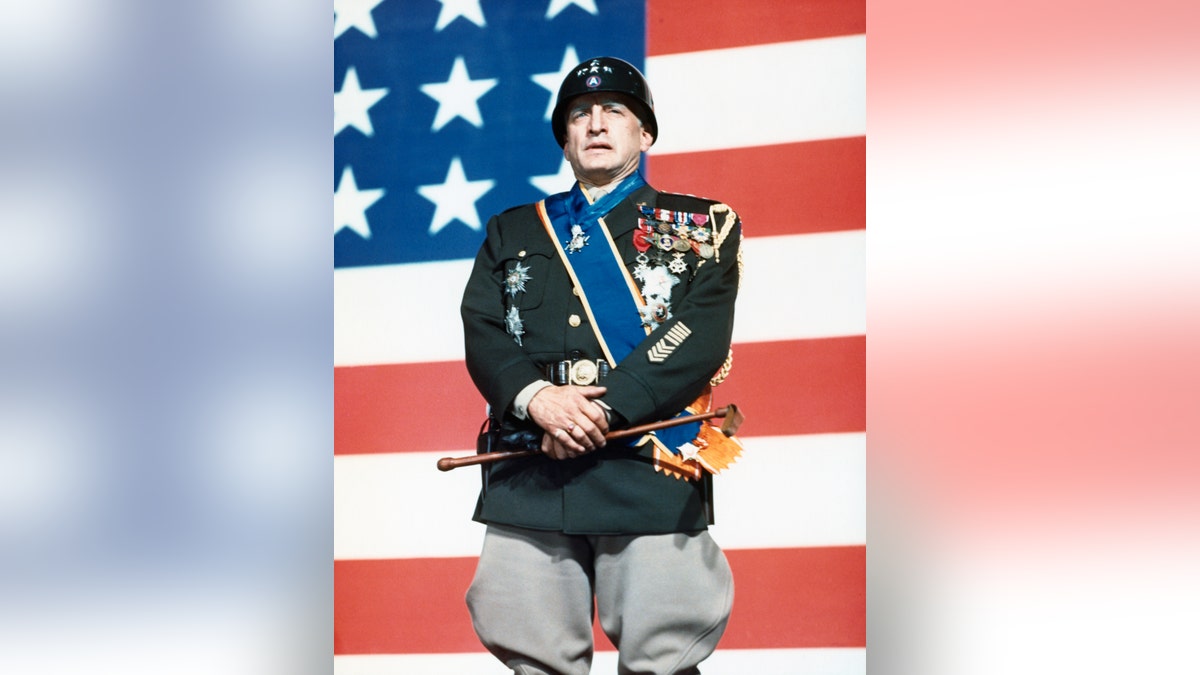
George C. Scott in character as General Patton. Scott won the best actor Oscar in 1971 but refused the award. (Herbert Dorfman/Corbis via Getty Images)
Anger and division over the Vietnam War reached a fever pitch in 1970 when Ohio National Guard troops shot and killed four students during a protest at Kent State College (now University) in Ohio.
Amid the national cultural crisis that year, the American flag emerged as a powerful unifying force in pop culture.
George C. Scott portrayed celebrated World War II general George Patton in the epic 1970 biopic "Patton." In the film's opening scene, he emerged to deliver a stirring patriotic monologue with an American flag filling the entire screen behind him.
The American flag emerged as a powerful unifying force in pop culture.
"Americans love a winner and will not tolerate a loser," Scott as Patton bellowed in the opening monologue. "Americans play to win all the time."
"Patton" won seven Academy Awards, including Best Picture. Scott won the Best Actor honors but declined the award.
1969: Buzz Aldrin plants Old Glory on the moon
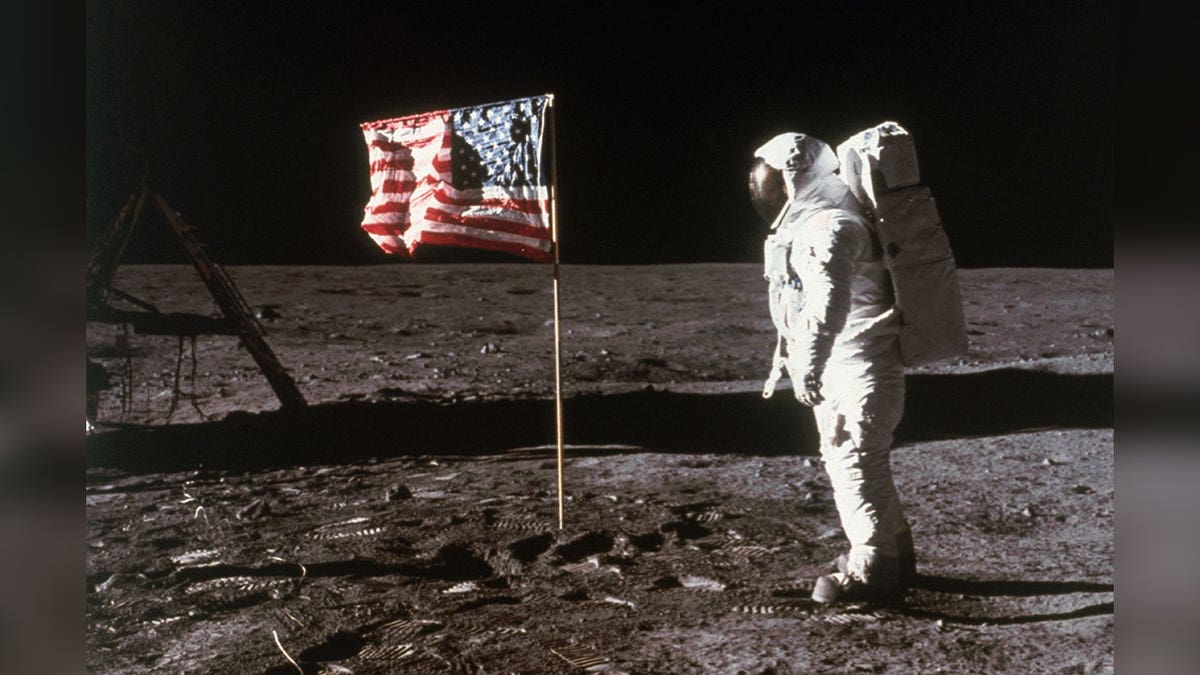
Astronaut Buzz Aldrin of the Apollo 11 mission stands beside an American flag placed on the moon in July 1969. (Bettmann/Contributor)
The United States remains the only nation that has landed humans on the moon — 12 men over six Apollo missions from 1969 to 1972. It’s the only nation, therefore, whose citizens have planted their national colors on another terrestrial body.
The first flag on the moon was planted by Apollo 11 astronauts Neil Armstrong and Buzz Aldrin during the first moon landing mission on July 20, 1969.
FIRST MEN ON THE MOON, A UNIQUE AMERICAN ACHIEVEMENT, STILL AMAZES US TODAY
Armstrong snapped a photo of Aldrin staring at the flag amid the gray moonscape and darkness of space that provided an unmistakable image of American exceptionalism and a symbol of victory over the Soviet Union in the space race.
1945: U.S. Marines raise the American flag over Iwo Jima
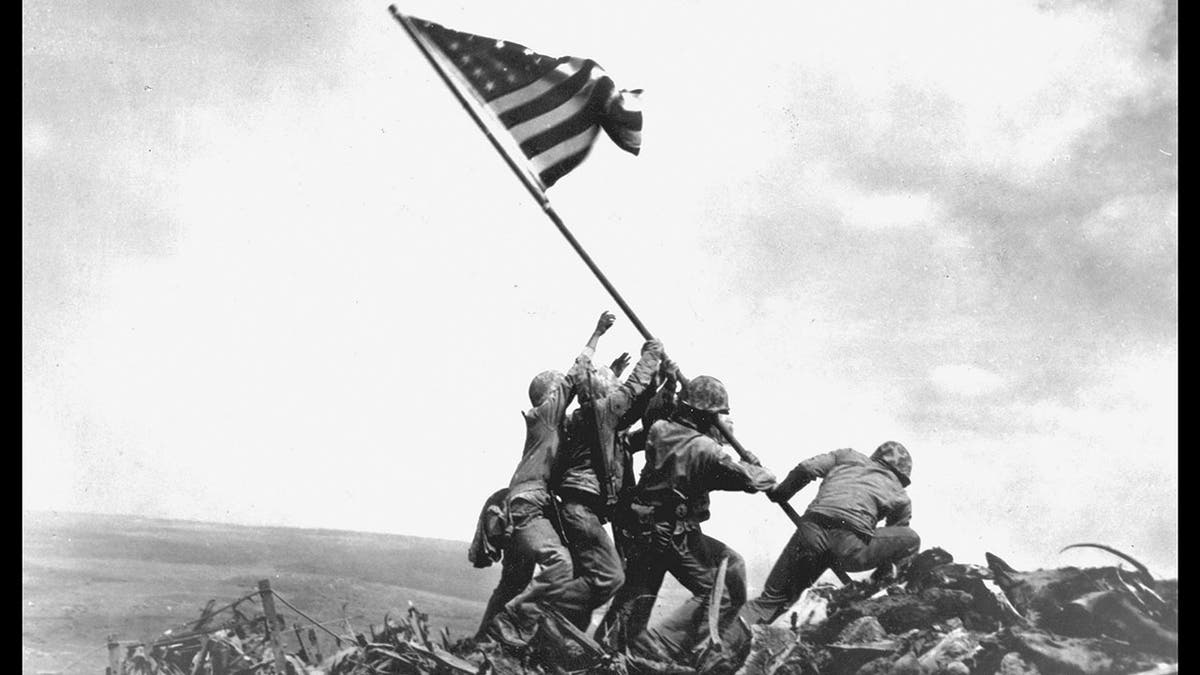
The view of members of the United States Marine Corps 5th Division as they raised an American flag on Mount Suribachi during the Battle of Iwo Jima, Feb. 23, 1945. (Joe Rosenthal/Photo 12/Universal Images Group via Getty Images)
Joe Rosenthal captured the triumphant image of six at-first unidentified boys hoisting the American flag atop Mount Suribachi as death swirled around them in the Battle of Iwo Jima during World War II.
"It was the first viral photograph," Conner, the curator at the National Museum of the Marine Corps, told Fox News Digital.
The image made an immediate impact on the war effort.
The image was relayed back to the United States by a primitive form of fax machine. Independent newspaper editors from coast to coast looked at the image and, in a recognition of its power and importance, placed it on the front page of their next editions.
The image made an immediate impact on the war effort, with the government using the image to raise $26 billion in just six weeks in a war bond drive.
The cultural impact of the image is unfathomable: It's considered by many the most significant photo in American history and perhaps the greatest ever wartime photo.
1814: ‘Our flag was still there’ over Fort McHenry

Francis Scott Key observes the bombardment and the U.S. flag over Fort McHenry in this artistic rendition. (Getty Images)
Francis Scott Key's view of the American flag flying in triumphant defiance over Fort McHenry on the morning of Sept. 13, 1814, was not captured by photo or painting as he saw it.
But the scene and his reaction to it were so powerful they still frame our national heritage and our daily culture today.
The American lawyer spent the night aboard a British ship in Baltimore Harbor, while negotiating for the release of U.S. prisoners. He had a front-row seat as the British unleashed a hellish firestorm upon Fort McHenry, just three weeks after they captured Washington, D.C. and burned down the White House and U.S. Capitol.
CLICK HERE TO SIGN UP FOR OUR LIFESTYLE NEWSLETTER
The young United States was on the brink of being conquered by its former colonizers.
Key was lit with patriotic fervor when he awoke "by the dawn’s early light" to find "our flag was still there."
The image he witnessed has been recast in artwork countless times and is reimagined in the hearts of Americans each time they sing the national anthem.
1776/1851: ‘Washington Crossing the Delaware’
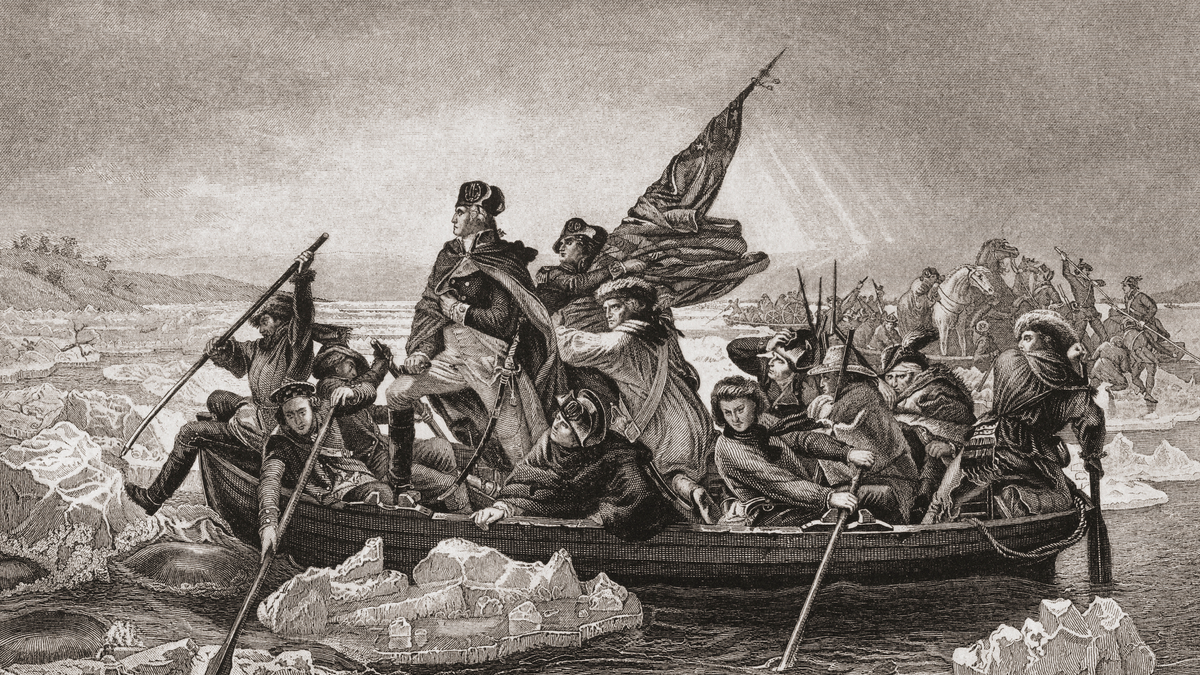
"Washington Crossing the Delaware," near Trenton, New Jersey, Christmas 1776. George Washington (1732-1799), first president of the United States. From English and Scottish history, published 1882. (Universal History Archive/Universal Images Group via Getty Images)
George Washington led his daring raid on Hessian troops on Christmas night 1776, saving the American Revolution from collapse and ultimately reshaping world history.
"This was a major military crossing under extraordinarily difficult circumstances," American Battlefield Trust historian Kristopher White told Fox News Digital.
MEET THE AMERICAN WHO ROWED WASHINGTON ACROSS THE DELAWARE ON CHRISTMAS, SAILOR-SOLDIER JOHN GLOVER
The attack immediately changed the fortunes of the war. But it was not truly portrayed in popular culture until German-American artist Emanuel Letuze completed his heroic oil-on-canvas painting in 1851.
CLICK HERE TO GET THE FOX NEWS APP
"Washington Crossing the Delaware" has been panned as inaccurate and overly dramatic. Certainly, the general was not standing proudly upright on the bitter cold night, nor was James Madison dutifully gripping the flag behind him.
But the painting nevertheless captures the heroism of the raid and pays homage to its outsized impact on American heritage.






















